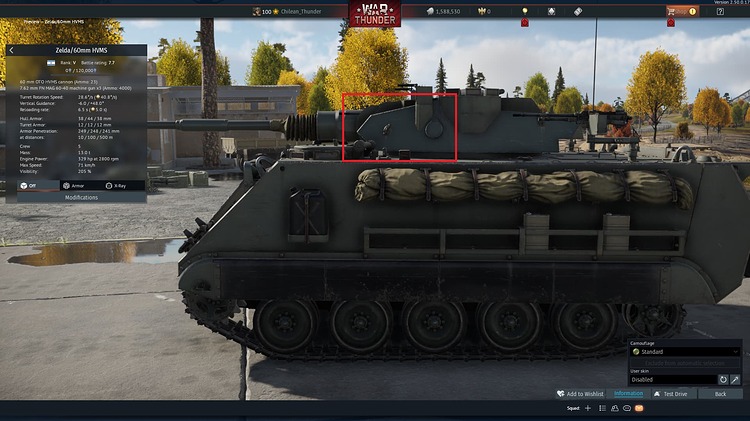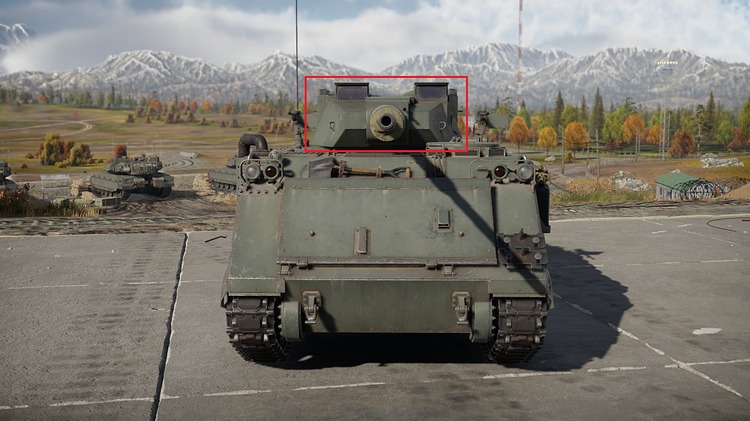- Yes
- No
FAMAE Piraña I 6x6 HVMS
History:
The construction of the Chilean Mowag Piraña was carried out by Industrias Cardoen and FAMAE (Fabricas y Maestranzas del Ejercito de Chile) in the early 1980s. Industrias Cardoen was a Chilean defense company, owned by Carlos Cardoen. Chile was one of the few countries that had Mowag’s license to build the Piranhas locally, thus building several of these vehicles in different configurations and different types of weapons. This version of the Chilean Mowag Piranha was built by FAMAE and is armed with the 60 mm IMI HVMS (Hyper Velocity Medium Support) cannon of Israeli origin that were obtained by Chile in the 1980s when Chile purchased the M-50 and M-51 from Israel. Later in 1988 the M-50 and the new cannons arrived in the country, then Chile armed its M-50 and M24 Chaffee with the Israeli cannon.

In 1992, a military fair was held in Chile where various companies from around the world showed their military vehicles. Among the companies that made their demonstrations was the Chilean national company FAMAE, belonging to the Chilean army. FAMAE showed two different versions of the Piranha vehicle built by them under license in its 6x6 and 8x8 versions, the 6x6 version was amphibious since it had propellers in the rear of the vehicle, it also had the turret manufactured by Israel Military Industries installed that was initially built to arm the Israeli M113 Zelda HVMS vehicle, the turret was capable of resisting projectiles of up to 14.5 mm which was impressive considering that turrets from other manufacturers only resisted up to calibers of 7.62 mm, the turret was armed with the 60 mm HVMS (Hypervelocity Medium Support) cannon capable of firing APFSDS-T, within the technical specifications of the turret, a laser rangefinder and a ballistic computer are also mentioned.

The cannon weighed 700 kg and as its name indicates, it was capable of firing APFSDS-T ammunition at high speed with a muzzle velocity of 1,620 m/s that could penetrate 120mm of armor angled at 60 degrees from a distance of 2,000 meters, which gave the new version of the Chilean Piraña a great anti-tank capacity. There was also supposedly a test where this gun managed to penetrate the side armor of two T-62 side by side at 2000 m, which would be ideal since at that time Chile had to deal with the T-55 of its neighbor Peru in the face of a possible conflict, this being the reason why this gun was installed in most Chilean tanks. It could also use high explosive ammunition that was used more for the destruction of bunkers and other objectives.
The new turret as mentioned above was designed by IMI to be used on Israeli M113, this new turret was operated by 2 people, the commander and the gunner, the commander was located on the left side of the gun where he could operate a machine gun located above his hatch and on the right side the gunner. The turret had two automatic reloading options, both recoil-powered. One has two three-round magazines mounted on the gun and the other four seven-round magazines mounted in the turret. Both systems permit firing in three-round bursts or semi-automatic fire. Three rounds can be fired in 1.5 seconds, but the full cyclic rate of fire is 100 rpm. The reload speed for both reloading systems is just 0.6 seconds. It is unknown which of these two reloading systems the Chilean Piraña 6x6 HVMS used, but both are incredibly efficient.
It is also worth mentioning that there were 2 different types of turrets, these being the early version (the one used in the game on the M113 HVMS) and the late one that was installed in the Chilean FAMAE Piranha 6x6, they can be differentiated in that the turret of the late version is arrow-shaped and more angled from the front, while the early version’s shape is not as angled and is straighter from the front, they also differ in the optics of the commander and the gunner, these being larger in the early version and smaller in the late version. The late turret installed in the Chilean Piranha also has some extra accessories such as the two sextuple smoke launchers and the pivot for the machine gun operated by the commander.

Finally, it is unknown what happened to this prototype, although it is most likely that it did not receive purchase orders either from the Chilean army or from any foreign country, so serial production of this variant did not occur. Currently the Chilean army still continues to use the Piraña 6x6 so I had the opportunity to record the interior of one of these vehicles, below I leave you the video.
Specifications:
- Crew:
- 3 (Commander, Gunner, Driver)
- Armament:
- Primary: 60 mm IMI HVMS (Hyper Velocity Medium Support) Gun
- Secondary: one 7.62 mm coaxial machine gun, one 7.62 mm anti-aircraft machine gun, two sextuple launchers of smoke grenades.
- Dimensions:
- Length: 5.97m
- Width: 2.5m
- Height: 1.85m (without turret)
- Weight: Total combat weight 10.500 kg, plus the weight of the turret and gun 2.500 kg
- Maneuverability :
- Engine: Detroit diesel 6V-53T
- Horse Power: 300 HP/2800 RPM
- Max. speed on roads: 100 km/h
- Speed in water: 10.5 km/h
- Power to weight ratio: 28,6 HP/TON
- Gear box: Allison MT-653
- Type: Automatic
- Gears: 5+1
- Max. gradient: 70%
- Lateral inclination: 30%
- Maximum obstacle height: 0,5 ms
- Turning circle: 11,3 ms
- Fuel tank capacity: 400 lts.
- Range: 1.200 kms.
- Additional system: fire extinguishing system that is activated in the engine once it exceeds a certain temperature. Amphibious capability.
- Accesories:
- Laser Rangefinder
- Ballistic Computer


Photos:

Sources:
- https://drive.google.com/file/d/1CwmpoTWov1lzWXGkvDCqGenuWXuKRDzR/view
- Famae-Cardoen Piraña (1981)
- Jane-s-Armour-and-Artillery-1993-94
- Janes_Armour_and_Artillery_Upgrades_2003-2004

















